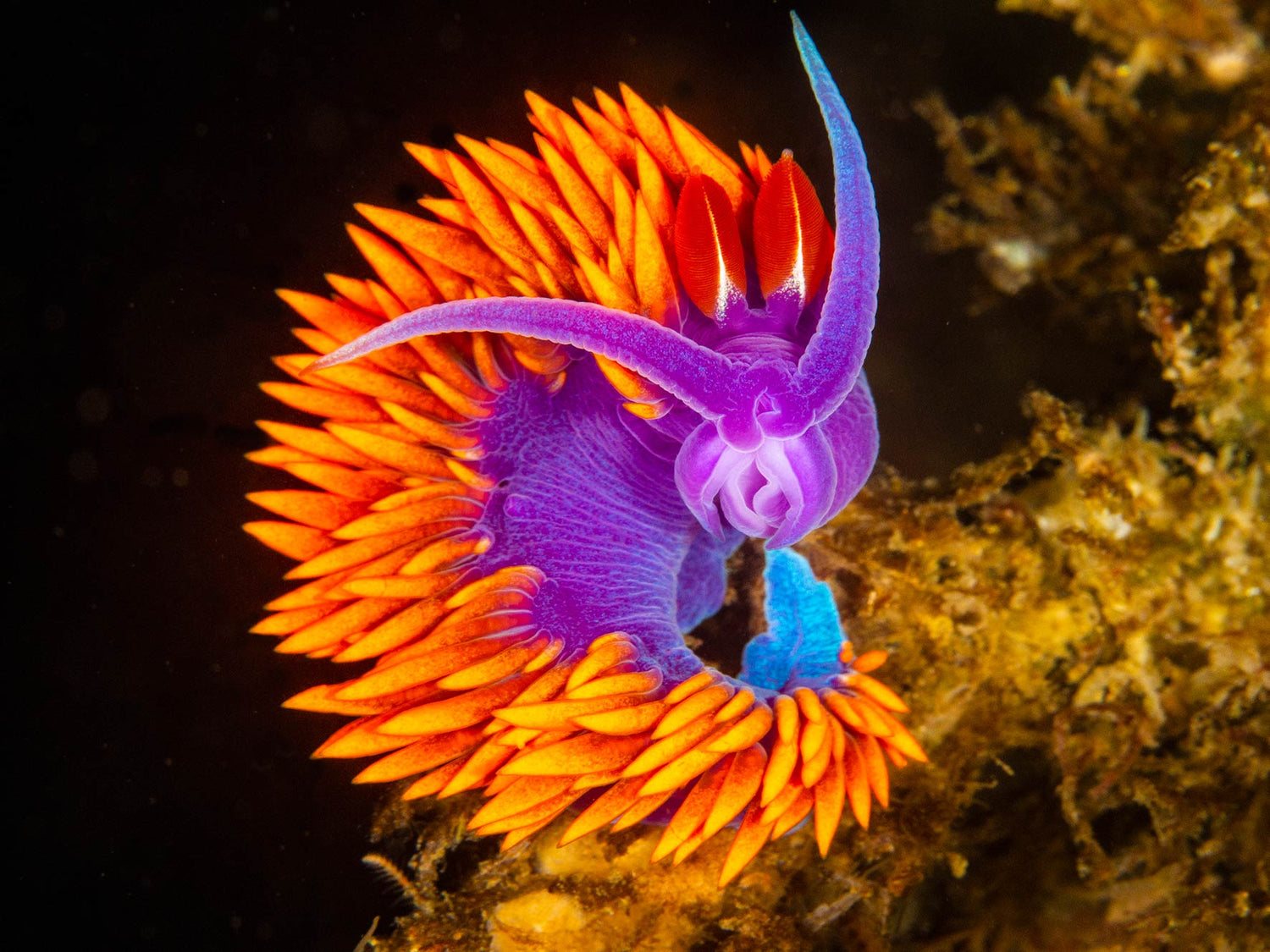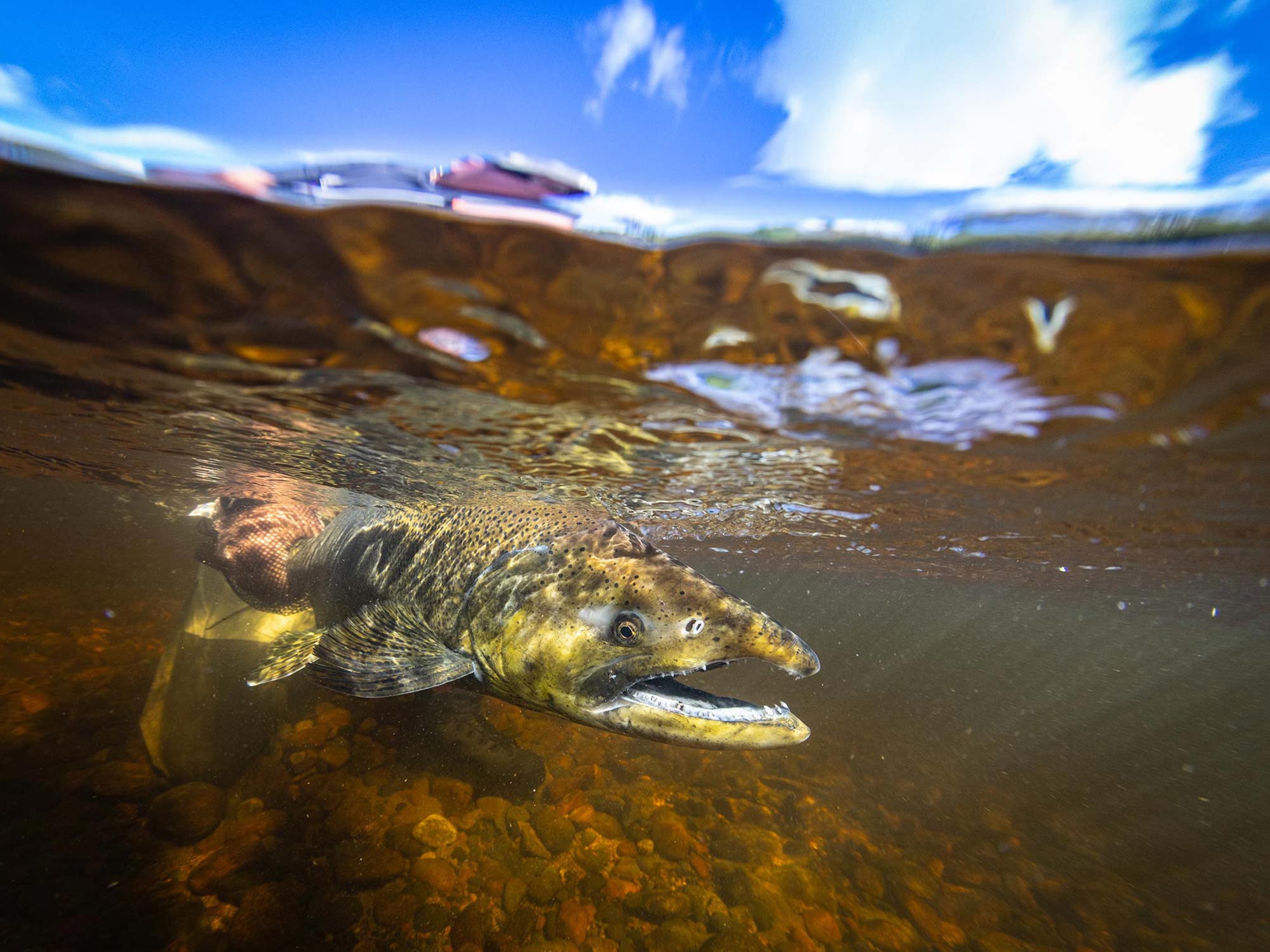By Douglas Klug
Divers along the whole stretch of the Eastern Pacific face an array of challenges that tropical resort divers can’t even fathom. For those of us who live along the stretch of North America between San Diego and the Central California diving mecca of Monterey, there are plenty of options to dive. It might not be the warm blue water from those SCUBA certification course videos, but there are stunning encounters, experiences, and even underwater photography opportunities to be had. Even when visibility is low and the surge is high, divers can venture out and, with the right mindset and some pre-planning, have great dives and bring back great photos.
I dive and shoot in sunny Southern California all year round. Temperatures along this portion of the Eastern Pacific range from the high 60’s (Fahrenheit) in the late summer down to the high 40’s (Fahrenheit) in the early spring. Visibility can be as good as 100’, or as bad as 5’. The surge is always present and sometimes strong enough to push or pull a diver more than 5’ one direction or another in just a few seconds. In cool Southern California waters, we can’t always shoot wide angle seascapes of kelp forests. In fact, for photographers looking to bring home striking images, odds of great shots are much better if you plan on shooting small stuff. Read on and I’ll share a few tips and tricks for making Southern California cold-water dives with the best chances of capturing macro images you’ll be proud of.
1 | Dress for success.
This has nothing to do with your camera or how you use it. Even water that’s in the high 60’s (Fahrenheit) at the surface can be quite cold at diving depths. If you’re shooting small stuff in Southern California, you won’t be moving around much and you might be patiently waiting in a single spot. If you’re in a wetsuit, think 7mm. Wear a hood and 3mm gloves, and get used to working with them. Many inexperienced cold-water divers shun the hood and gloves, complaining that the hood is uncomfortable, or they can’t work with their equipment (or camera) due to the 3mm (or thicker) gloves. If you have an ice-cream headache or your hands get too cold, you’ll see that finding and shooting a small subject becomes impossible. If you have the training, consider a drysuit over a wetsuit for better overall warmth.

The right gear helps you stay warm so you can you focus on finding and shooting macro subjects. © Douglas Klug
2 | Hold on loosely
Without a doubt, the hardest thing about shooting macro in Southern California is the persistent surge. Tracking or focusing on a tiny subject while being pushed back and forth by surge can be nearly impossible. Fortunately, many cold-water reefs are primarily rock with intermittent growth over them. Unlike fragile coral environments where an errant finger or fin can end decades of growth, a rock reef is a bit more forgiving. In strong surge, a diver with good buoyancy control can stabilize their macro shooting by holding onto bare rock or even a kelp holdfast with one hand and operating the camera with the other.

Here's an example of a typical Southern California reef. Note the large sections of bare rock that could make a stabilizing hand-hold for a diver trying to shoot macro in the surge. © Douglas Klug
3 | Work with the ocean’s motion
Surge is the bane of macro shooters. Even if you’re stabilized by holding on, your subject is likely getting whipped around by the ocean. Sometimes, if you’re patient, that surge will push your subject into a pleasing composition. If you hold your position until this happens, you’ll have a few seconds to compose and complete the shot.

Here’s an example of how the surge can push a soft-bodied nudibranch into a pleasing composition by lifting it up and away from the camera while pushing its rhinophores and oral tentacles back. © Douglas Klug
4 | Swim slow and low
I teach this concept in a Southern California nudibranch ID course, but it applies to all types of small marine life. Cold waters are rich with marine life including fish and mollusks, some of which are camouflaged on the reef. If you’re looking for subjects that are only an inch long, you probably won’t see them from 6’ off the bottom. Divers in cold water can take advantage of the rock reefs and even “finger walk” over the reef, making careful of placement of fingers on bare rock. Getting within an arms distance of the reef will open your eyes to all sorts of tiny, colorful, hidden critters.

A tiny coralline sculpin is blends in with the bare rock reef. © Douglas Klug

A colorful jeweled topsnail moves along the edge of a reef. © Douglas Klug
5 | Look up, down, and all around
Divers and underwater photographers often focus on the two-dimensional world playing out beneath them as they glide over a reef in perfect neutrally bouyant bliss. The cold water reefs in Southern California are truly three-dimensional and even the tiny critters seem to always be striving to get off that flat rock reef. Some of my favorite Southern California macro images involve subjects suspended off the reef by whatever they can climb on. The bonus to this is with the right lighting and focus, you can turn the watery background black or blur the reef background to make your subject really “pop” out of the image.

A nudibranch crawls up the edge of a hydroid colony. © Douglas Klug

An amphipod crawls out on the tip of a gorgonian branch. © Douglas Klug
6 | Look for reef buddies
Macro shots are often about brilliant colors and detail. To make them even better, try to find tiny critters positioned so they appear to be interacting with one another. Sometimes it’s a true interaction, other times it's just where they happen to be with respect to one another. Either way, capturing interaction can make a good macro shot great.

This nudibranch appears to be having a face-off with a tiny sculpin. © Douglas Klug

A trio of island kelpfish share real-estate inside an empty shell. © Douglas Klug
Remember, the cold water may be daunting, but the potential for stunning macro images makes it well worth the challenge. I hope you’ll find some of these tips and tricks useful if you ever find yourself diving Southern California reefs for macro underwater photography.

Douglas Klug is a SCUBA diving instructor and underwater photographer in Santa Barbara, CA. Doug has been diving California’s Channel Islands for over 30 years and has logged thousands of dives in the kelp forests around Anacapa, Santa Cruz, Santa Rosa, and San Miguel Island. Doug specializes in underwater photography within the kelp forest environment. Doug’s photo-essays have been published in print world-wide, including articles in California Diving News, DAN Alert Diver, and Dive Training. Doug’s images have been used in numerous print and digital formats including use by the US National Park Service, US National Marine Sanctuary, and the Monterey Bay Aquarium, Google, and Microsoft. Doug even does live talks on underwater photography for dive clubs and museums in Southern California. In addition to underwater photography and other SCUBA courses, Doug even teaches a SCUBA course on Southern California Nudibranch Identification for divers who want to learn the names of some of the coolest “macro” critters on kelp forest reefs.
Additional Reading
Reflections: Manipulation with Mirrors and Light for Behavioral Images
Underwater Cathedrals: Shooting Magnificent Kelp Forests
Customer Photos | Douglas Klug in California's Kelp Forests and Beyond
An Insider's Guide to Shore Diving Catalina Island
Super Macro Underwater Photography Techniques
Nudibranch Underwater Camera Settings and Technique













![Custom White Balance for Underwater with Canon Mirrorless Cameras [VIDEO]](http://www.ikelite.com/cdn/shop/articles/manual-wb-cover.jpg?v=1676591383&width=2001)